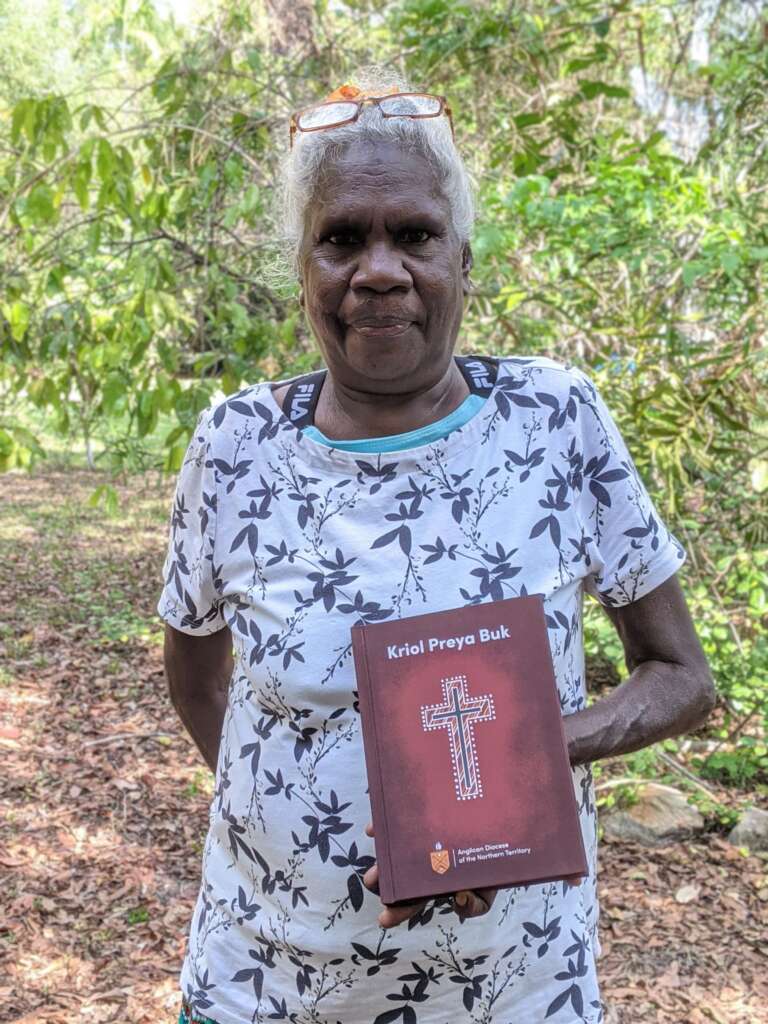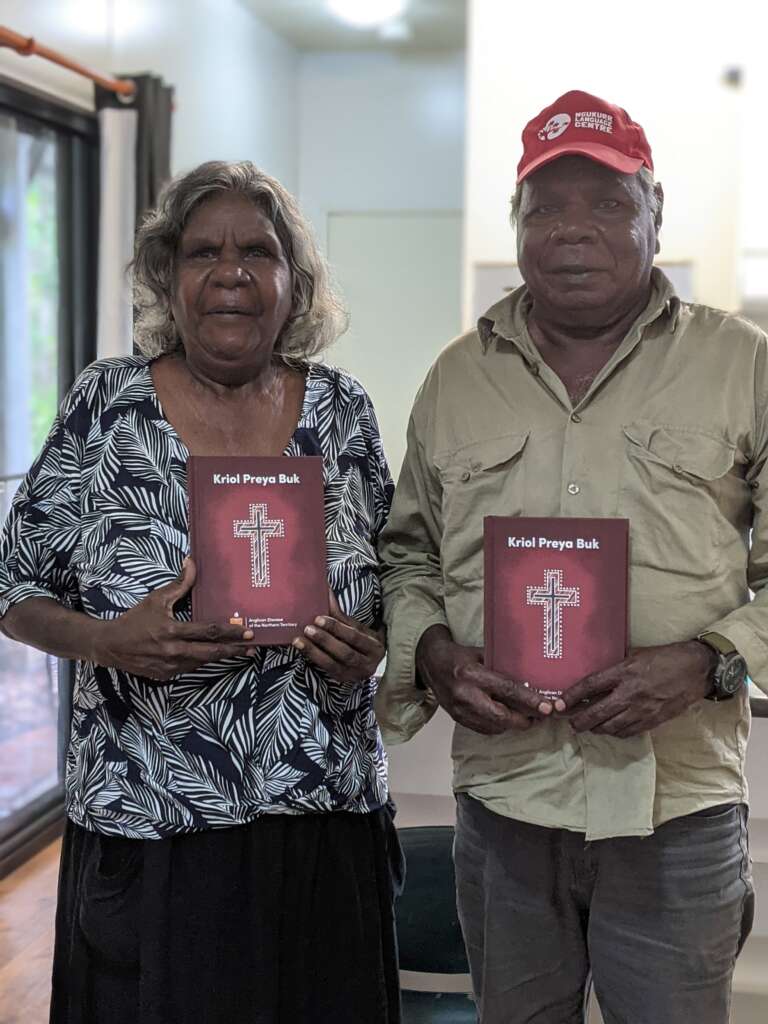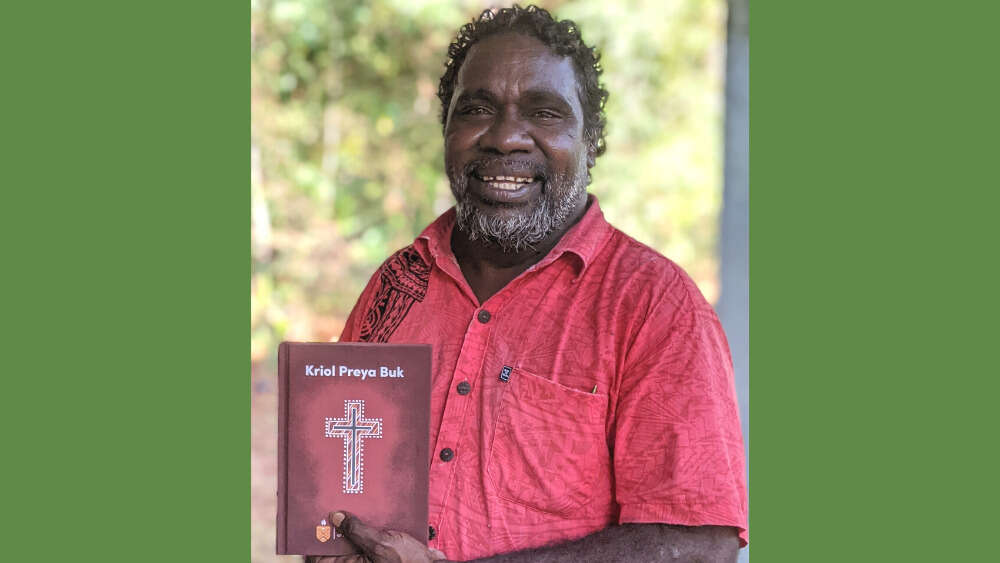Kriol Preya Buk passes a big story down through the generations
The Book of Common Prayer, published in 1662, was the standard of English-speaking church worship for 300 years. Now, its precious principles are being passed on to the many thousands of Kriol speakers in the Northern Territory.
The new Kriol Preya Book is the result of almost ten years of work by a team of more than 23 Kriol-speaking translators from different communities in the Top End.
Officially launched at a special celebration on Friday, September 17, at Darwin’s Christ Church Anglican Cathedral, the Kriol Preya Book brings together in one handsome volume a comprehensive suite of liturgy, prayers and responses for all Kriol Christians. It passes a big story down through the generations, with ordinary Sunday services, special occasions like baptisms, confirmation and funerals, a range of prayers for healing, and statements of Christian doctrine including the Nicene Creed and the 39 Articles.
“We want people in their home communities to be able to worship God in a way that’s meaningful for them.” – Greg Anderson
The book has been crafted to make it easy for the congregation to participate, regardless of how strong their Kriol literacy is.
Greg Anderson, the NT Anglican Bishop, says that an important principle for Anglicans for hundreds of years has been Christians worshipping God in their own language. “We want people in their home communities to be able to worship God in a way that’s meaningful for them,” he said. “And so, honouring God’s gift of language, rather than imposing a language from outside, is very important.”
Among the more than 100 people from around the Territory who gathered to celebrate the launch of the Preya Buk was Darryn Farrell, the Deacon in charge at Minyerri community, 240 km southeast of Katherine. He has been involved in the translation work from its inception in 2012, and his artwork of a cross adorns the front cover.
He says the Kriol Preya Buk will allow his people to connect and participate at a heart level in any form of prayer, whether it be in church, at home, or in hospitals.
“I’ve been reading English and learning it for a long time, and I pretty much know its rhythm, how it goes, but reading in Kriol, in my language, it’s like me saying these things and it’s just there, already written, with its own rhythm,” he says.
“This one I was thinking of mainly for the next generation.” – Carol Robertson
Carol Robertson, a retired Anglican priest from Ngukurr, in southern Arnhem Land, says she and the other translators just wanted to make the prayer book easier for the young leaders, who struggle with English but also struggle with literacy in their heart language of Kriol.
“This one I was thinking of mainly for the next generation. This simple version will be easy for them and will support them,” she says.

Carol Robertson
Because many Kriol speakers struggle to read their spoken heart language, the context of the Kriol Preya Buk in the Territory is similar to the society in which the original English prayer book was created hundreds of years ago in England, explains NT Anglican church facilitator, the Reverend Kate Beer.
“When the liturgy of the original prayer book moved from Latin to English, a lot of the people who were attending a church service wouldn’t necessarily have been able to read,” she says.
“So we’ve worked very hard as a team, as with the original prayer book, to craft very memorable responses so that people can quite easily participate in what’s going on because the word liturgy is the work of the people.”
“The care has been not only in just translation but in trying to come up with something that’s got a metre and rhythm, poetry to it, and rich images as well.”
“The care has been not only in just translation but in trying to come up with something that’s got a metre and rhythm, poetry to it, and rich images as well.” – Kate Beer
She believes the Preya Buk will be a springboard for translators to hand on “all they’ve learned and come to know about how their faith is working in their own culture and their own place. It’s a uniting thing and it enables people.”

Marjorie and William Hall
Translator Marjorie Hall, who is Deacon in charge at Ngukurr with her husband William, believes some of the most useful prayers in the book are those for the sick.
“It helps me to open up my book if somebody is in the hospital and we can have prayer. Maybe somebody is sick, or somebody passes away, and somebody is mourning, chaplains can go into hospital and they have this prayer book to help the family talk to God about that person.”
“Chaplains can go into hospital and they have this prayer book to help the family talk to God about that person.” – Marjorie Hall
While the project took ten years, the past six months were a time of deep thinking and processing as a group of Kriol translators pulled out all the stops to include a translation of the Nicene Creed in the new Kriol Preya Buk.
Kate Beer reports that the translators were so excited when they managed to get the Nicene Creed down in a way they were happy with that they wanted to take it back to use in their communities straightaway, without waiting for the full Preya Buk to be printed.
“When I started reading it, my heart started pounding right inside, I could feel that as I was going through,” says Darryn Farrell.
“And it was not just me, but there were other leaders also going through the same thing and they felt the same thing. We felt an unexplained happiness inside. I couldn’t explain it except that God had given you eyes to see the real words.”
Greg Anderson believed it was important to include the Nicene Creed because it was “developed at a point in church history where there were controversies about who exactly Jesus was.”
“The Nicene Creed sets out that Christians, orthodox Christians, believe that Jesus was one with God. God is Trinity – Father, Son and Holy Spirit, there from all eternity. So to have those doctrinal truths set out in the Nicene Creed is I believe really significant for the doctrinal foundations of our faith, particularly with regard to who Jesus is.”
“Nicene Creed:
Wi bilib langa wanbala God,
im na det Dedi, weya garram ola pawa.
Imbin meigim hebin, en dijan graun. Imbin meigim ebrijing weya wi gin luk
en ebrijing weya wi kaan luk du.
Wi bilib langa wanbala Bos, Jisas Krais. Im na det oni San blanga God.
Bifo enijing bin jidan,
imbin jidan garram Dedi God,
en im kipgon jidan olagijawan. God brom God, Lait brom Lait
trubala God brom trubala God. Imbin deya garram Dedi God, olataim. Imbin oldei det San blanga God;
God nomo bin meigim im.
Dumaji im God, seim laik im Dedi.
En thru det San na, Dedi God bin meigim ebrijing.
Imbin kamdan brom hebin
blanga jidan garram wi, en blanga seibum wi.
Blanga tharran na det Holi Spirit bin kaman en jidan langa Meri
en bambai Jisas bin bon.
Blanga wi na,
Jisas bin gibit miselp blanga go thru
langa det trabul:
wen Panshas Pailat bin det lida, deibim neilimap Jisas langa det kros.
Deya na imbin dai
en afta, deibin pudum im langa det greib.
Thrideistaim Jisas bin gidap laibala
laik ola speshalwan mesinja blanga God
bin tok longtaim;
en imbin gowap langa hebin
weya im jidan raitensaid langa Dedi God. Im garra kambek igin
garram im shainiwan lait en detmatj pawa, blanga kotim ebribodi;
detlot pipul hu jidan laibala, en detlot pipul hubin dai du.
En afta, Jisas garra jidan Bos, olagijawan!
Wi bilib langa det Holi Spirit,
det Bos, weya gibit wi laif,
hubin kaman brom det Dedi en det San. Garram det Dedi en det San,
wi garra weship
en libdimap im neim brabli haibala.
Det Holi Spirit bin tok thru langa detlot speshalwan mesinja brom God.
Wi bilib God bin meigim Kristjan pipul
jidan wanbala nyukurrwan tjetj olagijawan,
hubin kaman brom detlot aposul. Wi bulurrum oni wanbala beptisim
weya God larramgo fri detlot pipul brom olabat nogudbalawei.
Wi weidabat blanga det taim wen God garra meigim pipul gidap laibala brom dedbala
en wen wi garra jidan olagijawan
langa det nyubala hom weya kaan neba binij.
Trubala.
Email This Story
Why not send this to a friend?


